Rapid changes in competition, demand, technology, and regulations have made it more important than ever for organizations to be able to respond and adapt quickly. But according to a recent McKinsey Global Survey, organizational agility—the ability to quickly reconfigure strategy, structure, processes, people, and technology toward value-creating and value-protecting opportunities—is elusive for most.1 Many respondents say their companies have not yet fully implemented agile ways of working, either company-wide or in the performance units where they work,2 though the advantages are clear. Respondents in agile units report better performance than all others do, and companies in more volatile or uncertain environments are more likely than others to be pursuing agile transformations.
Stay current on your favorite topics
Few companies are yet reaping these benefits, but that may soon change; the results also indicate that organizational agility is catching fire. For many respondents, agility ranks as a high strategic priority in their performance units. Moreover, companies are transforming activities in several parts of the organization—from innovation and customer experience to operations and strategy—to become more agile. Finally, respondents in all sectors believe more of their employees should be working in agile ways. For organizations and their performance units that aren’t yet agile, the path to achieving agility depends on their starting points. But the results indicate some clear guidance on how and where they can improve, whether they are lacking in stability or dynamism.
Organizational agility is on the rise
Across industries and regions, most survey participants agree that the world around them is changing, and quickly. Business environments are increasingly complex and volatile, with two-thirds of respondents saying their sectors are characterized by rapid change. In such environments, the need for companies to demonstrate agility is top of mind: the more unstable that respondents say their environments are, the more likely they are to say their companies have begun agile transformations (Exhibit 1).
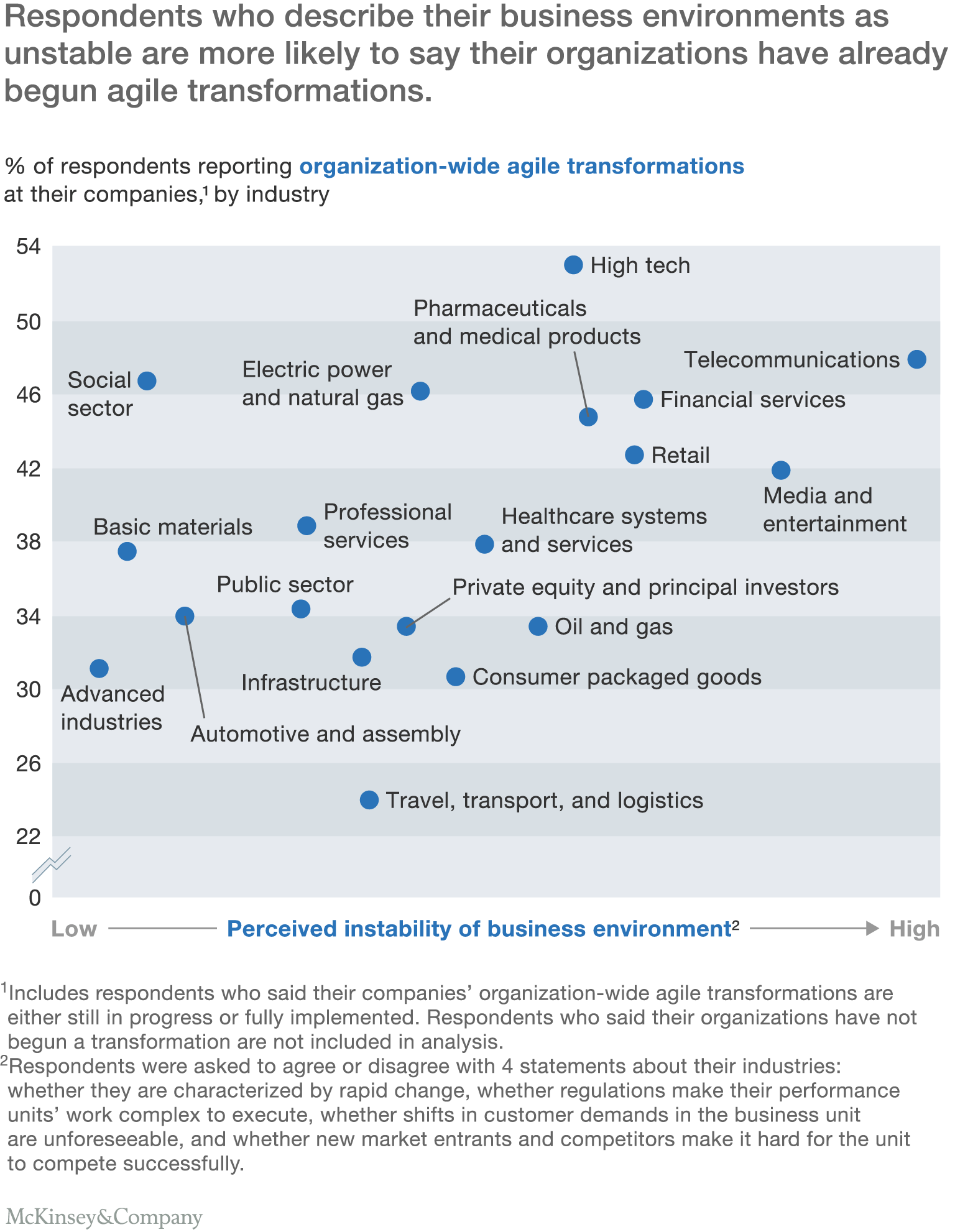
To date, though, few organization-wide agile transformations have been completed. Only 4 percent of all respondents say their companies have fully implemented one, though another 37 percent say company-wide transformations are in progress. When asked where their companies apply agile ways of working,3 respondents most often identify activities that are closest to the customer: innovation, customer experience, sales and servicing, and product management.4 This is not too surprising, since customer centricity is cited most often—followed by productivity and employee engagement—as the objective of agile transformations. Companies are also focusing on internal end-to-end processes. At least four in ten respondents say their companies are applying agile ways of working in processes related to operations, strategy, and technology, while roughly one-third say they are doing so in supply-chain management and talent management.5
Would you like to learn more about our People & Organizational Performance Practice?
Looking forward, the results suggest that companies have higher aspirations for agility. Three-quarters of respondents say organizational agility is a top or top-three priority on their units’ agendas, and more transformations appear to be on the way. Of those who have not begun agile transformations, more than half say plans for either unit-level or company-wide transformations are in the works. Respondents across industries also report a desire to scale up agile ways of working. On average, they believe 68 percent of their companies’ employees should be working in agile ways, compared with the 44 percent of employees who currently do. By industry, respondents in telecom and the electric-power and natural-gas industries report the biggest differences between their actual and ideal shares of employees working in agile ways—followed closely by respondents in several other industries: media and entertainment, the public sector, oil and gas, pharma, and advanced industries.
What’s more, the survey also confirms that agility pays off. Eighty-one percent of respondents in agile units report a moderate or significant increase in overall performance since their transformations began. And on average, respondents in agile units are 1.5 times more likely than others to report financial outperformance relative to peers, and 1.7 times more likely to report outperforming their peers on nonfinancial measures.6
Agile organizations excel at both stability and dynamism
In previous work, we have determined that, to be agile, an organization needs to be both dynamic and stable.7 Dynamic practices enable companies to respond nimbly and quickly to new challenges and opportunities, while stable practices cultivate reliability and efficiency by establishing a backbone of elements that don’t need to change frequently. The survey scored organizations across eighteen practices (see sidebar, “Eighteen practices for organizational agility.”), which our research suggests are all critical for achieving organizational agility. According to the results, less than one-quarter of performance units are agile. The remaining performance units lack either dynamism, stability, or both (Exhibit 2).
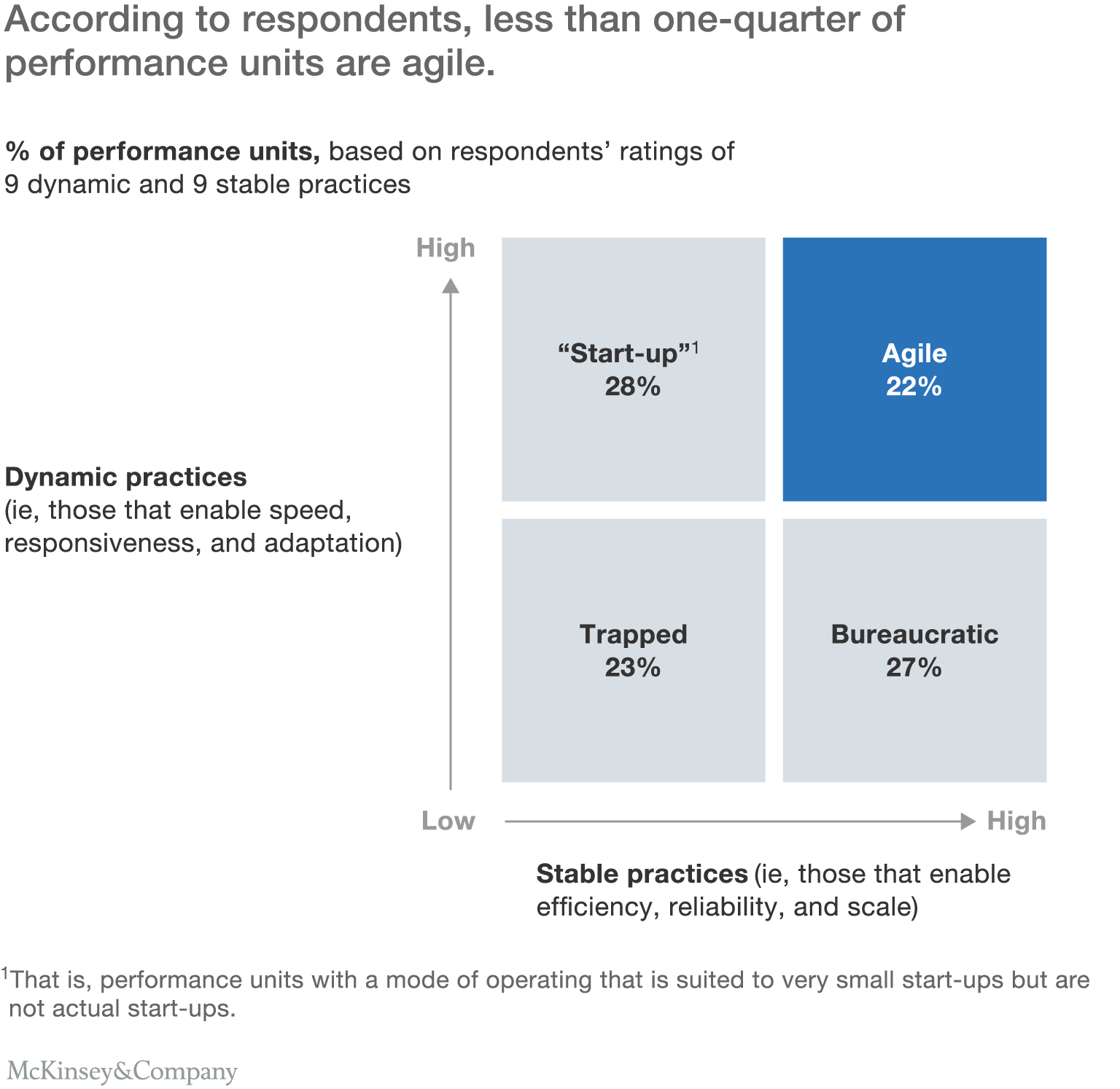
Of the 18 practices, the 3 where agile units most often excel relate to strategy and people (Exhibit 3). More than 90 percent of agile respondents say that their leaders provide actionable strategic guidance (that is, each team’s daily work is guided by concrete outcomes that advance the strategy); that they have established a shared vision and purpose (namely, that people feel personally and emotionally engaged in their work and are actively involved in refining the strategic direction); and that people in their unit are entrepreneurial (in other words, they proactively identify and pursue opportunities to develop in their daily work). By contrast, just about half of their peers in nonagile units say the same.

After strategy, agile units most often follow four stable practices related to process and people: entrepreneurial drive, shared and servant leadership, standardized ways of working, and cohesive community. When looking more closely at standardized ways of working, the agile units excel most on two actions: the unit’s processes are enabled by shared digital platforms and tools (91 percent, compared with 54 percent for others), and processes are standardized, including the use of a common language and common tools (cited by 90 percent of agile respondents and just 58 percent of all others).
Among the dynamic practices, process—and information transparency, in particular—is a strength for agile units. Within transparency, for example, 90 percent of agile respondents say information on everything from customers to financials is freely available to employees. Among their peers in other units, only 49 percent say the same. The second practice where agile units most differ from others is in rapid iteration and experimentation. More than 80 percent of agile respondents say their companies’ new products and services are developed in close interaction with customers and that ideas and prototypes are field-tested early in the development process, so units can quickly gather data on possible improvements.
The path to agility depends on the starting point
For the performance units that aren’t yet agile, the survey results suggest clear guidance for how to move forward. But organizational agility is not a one-size-fits-all undertaking. The specific practices a unit or organization should focus on to become agile depend on whether it is currently bureaucratic, start-up, or trapped.
Bureaucratic units
By definition, bureaucratic units are relatively low in dynamism and most often characterized by reliability, standard ways of working, risk aversion, silos, and efficiency. To overcome the established norms that keep them from moving fast, these units need to develop further their dynamic practices and modify their stable backbones, especially on practices related to people, process, and structure.

ING’s agile transformation
First is the need to address the dynamic practices where, compared with agile units, the bureaucratic units are furthest behind (Exhibit 4). Only 29 percent of bureaucratic respondents, for example, report following rapid iteration and experimentation, while 81 percent of agile respondents say the same. A particular weakness in this area is the use of minimum viable products to quickly test new ideas: just 19 percent of bureaucratic respondents report doing so, compared with 74 percent of agile respondents. After that, the largest gap between bureaucratic units and agile units is their ability to roll out suitable technology, systems, and tools that support agile ways of working.
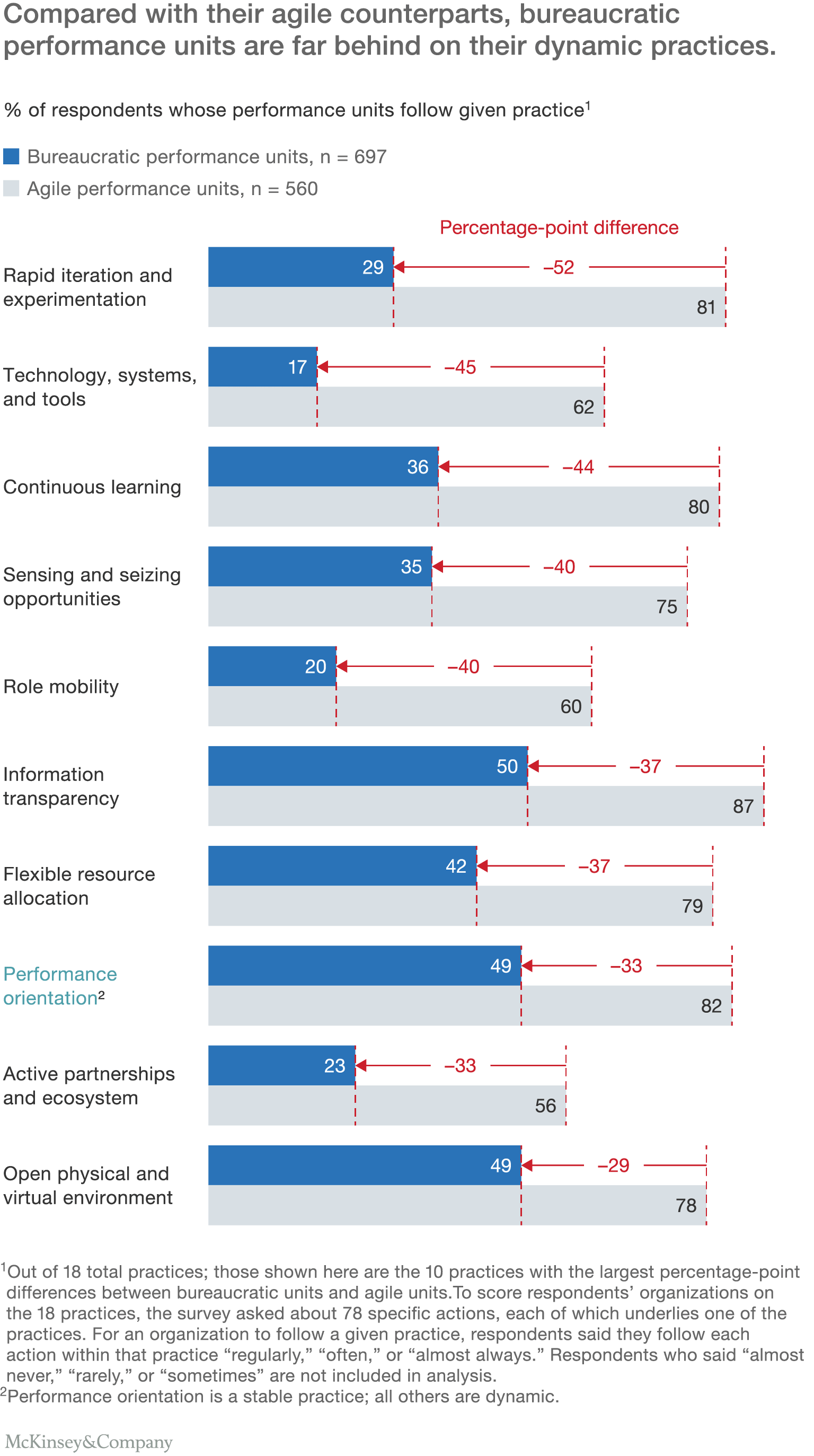
At the same time, bureaucratic units also have room to improve on certain stable practices (Exhibit 5). For example, bureaucratic units are furthest behind in performance orientation; in agile units, employees are far more likely to provide each other with continuous feedback on both their behavior and their business outcomes. What’s more, leaders in these units are better at embracing shared and servant leadership by more frequently incentivizing team-oriented behavior and investing in employee development. And it’s much more common in agile units to create small teams that are fully accountable for completing a defined process or service.
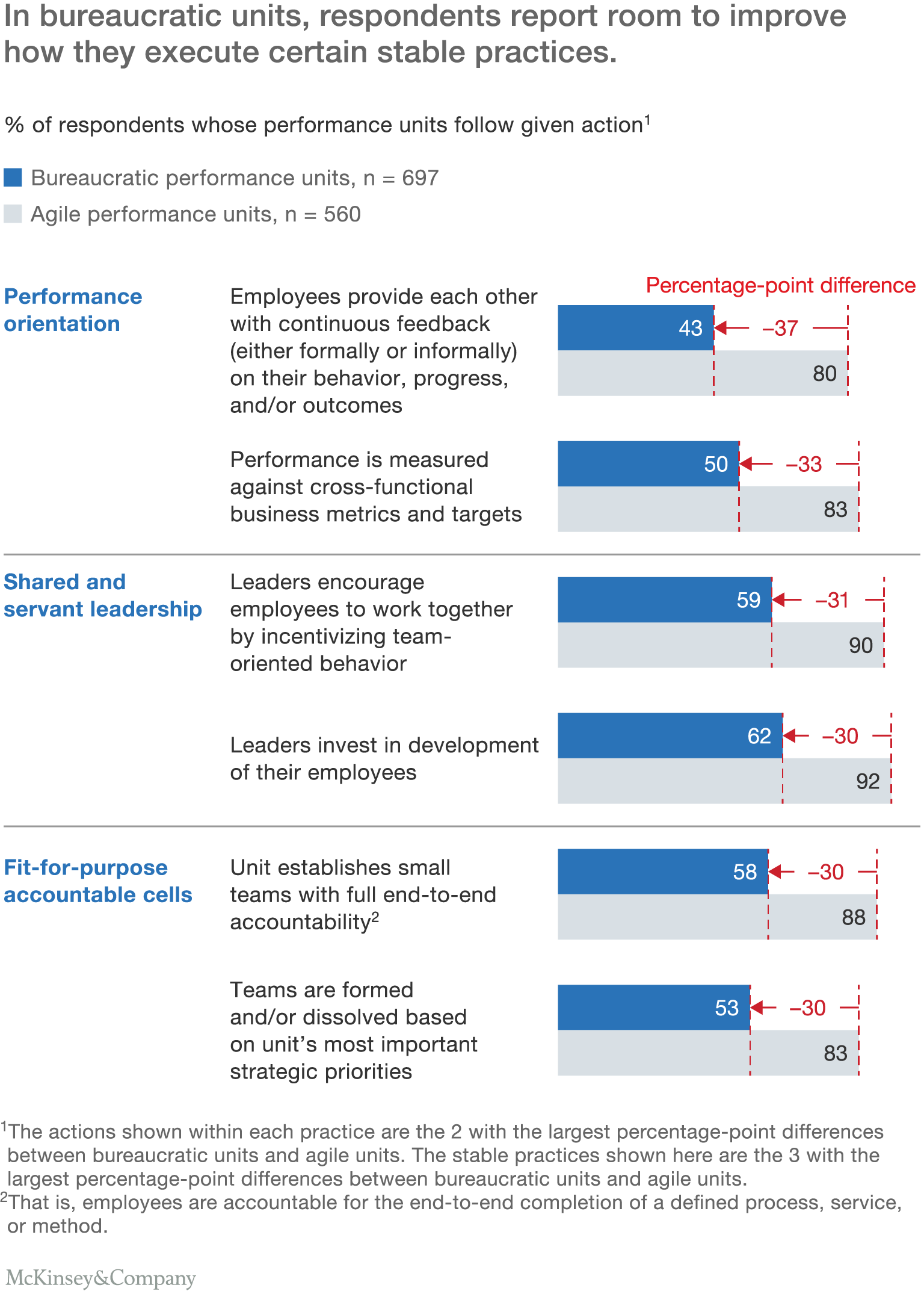
Start-up units
Start-up units, on the other hand, are low in stability and characterized as creative, ad hoc, constantly shifting focus, unpredictable, and reinventing the wheel. These organizations tend to act quickly but often lack discipline and systematic execution. To overcome the tendencies that keep them from sustaining effective operations, these units need to further develop all of their stable practices—and also broaden their use of the dynamic practices related to process and strategy in order to maintain sufficient speed.
First is focusing on a stronger overall stable backbone. On average, 55 percent of start-up respondents report that they implement all nine stable practices, compared with 88 percent of agile respondents who report the same. According to the results, a particular sore spot is people-related practices—especially shared and servant leadership (Exhibit 6). For example, just under half of start-up respondents say their leaders involve employees in strategic and organizational decisions that affect them, compared with 85 percent of their agile peers. Similar to bureaucratic units, respondents at start-up units also report challenges with process, particularly with regard to performance orientation. Within that practice, only 44 percent of respondents at start-up units say their people provide each other with continuous feedback on both their behavior and their business outcomes; 80 percent at agile units report the same.
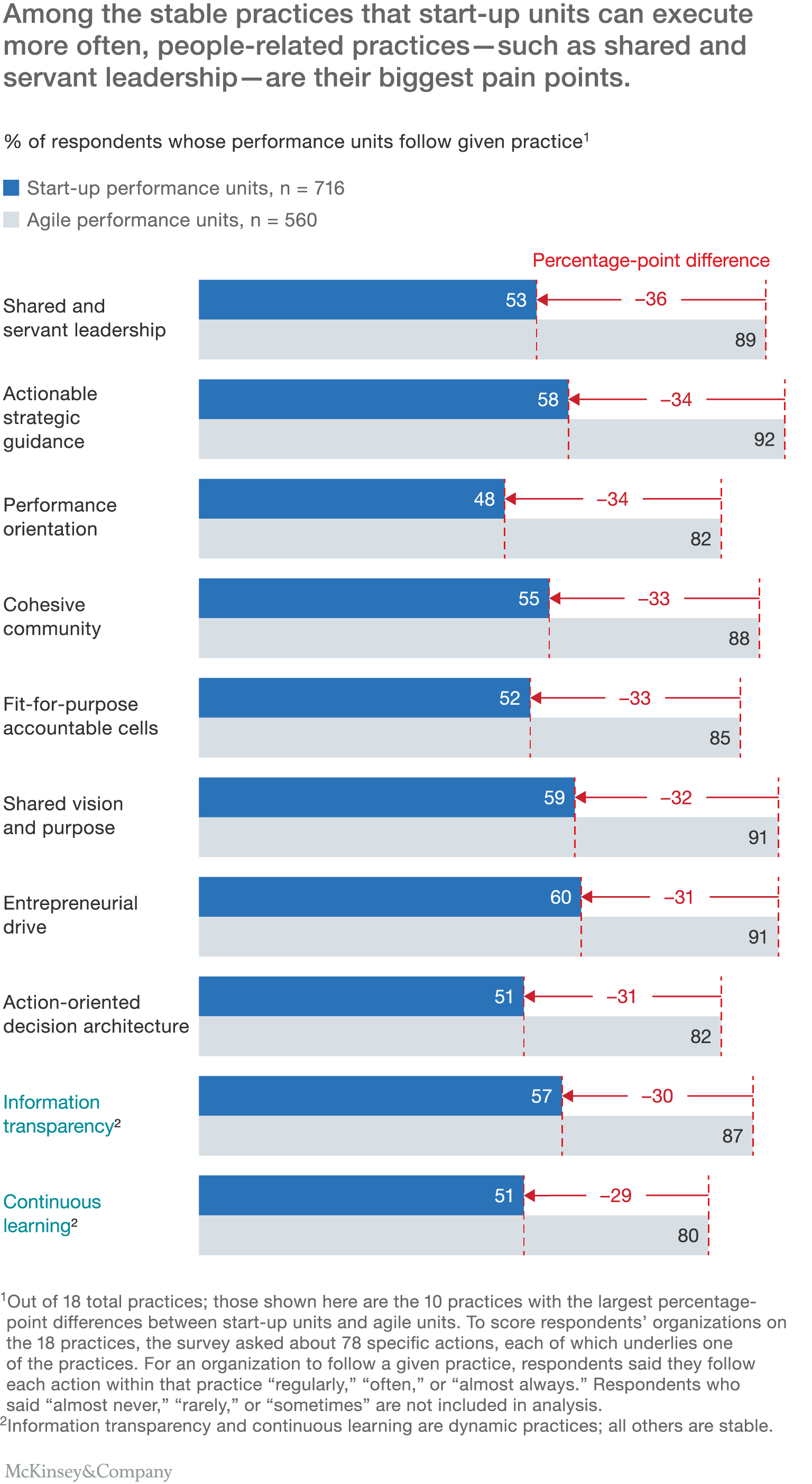
Start-up units also have room to improve their use of dynamic practices, particularly in process and strategy. According to respondents, the agile units excel much more often than their start-up counterparts at information transparency—for example, holding events where people and teams share their work with the unit (Exhibit 7). Moreover, agile respondents are much more likely to say new knowledge and capabilities are available to the whole unit, which enables continuous learning. On the strategy front, the start-up units are furthest behind their agile peers on flexible resource allocation—more specifically, deploying their key resources to new pilots and initiatives based on progress against milestones.
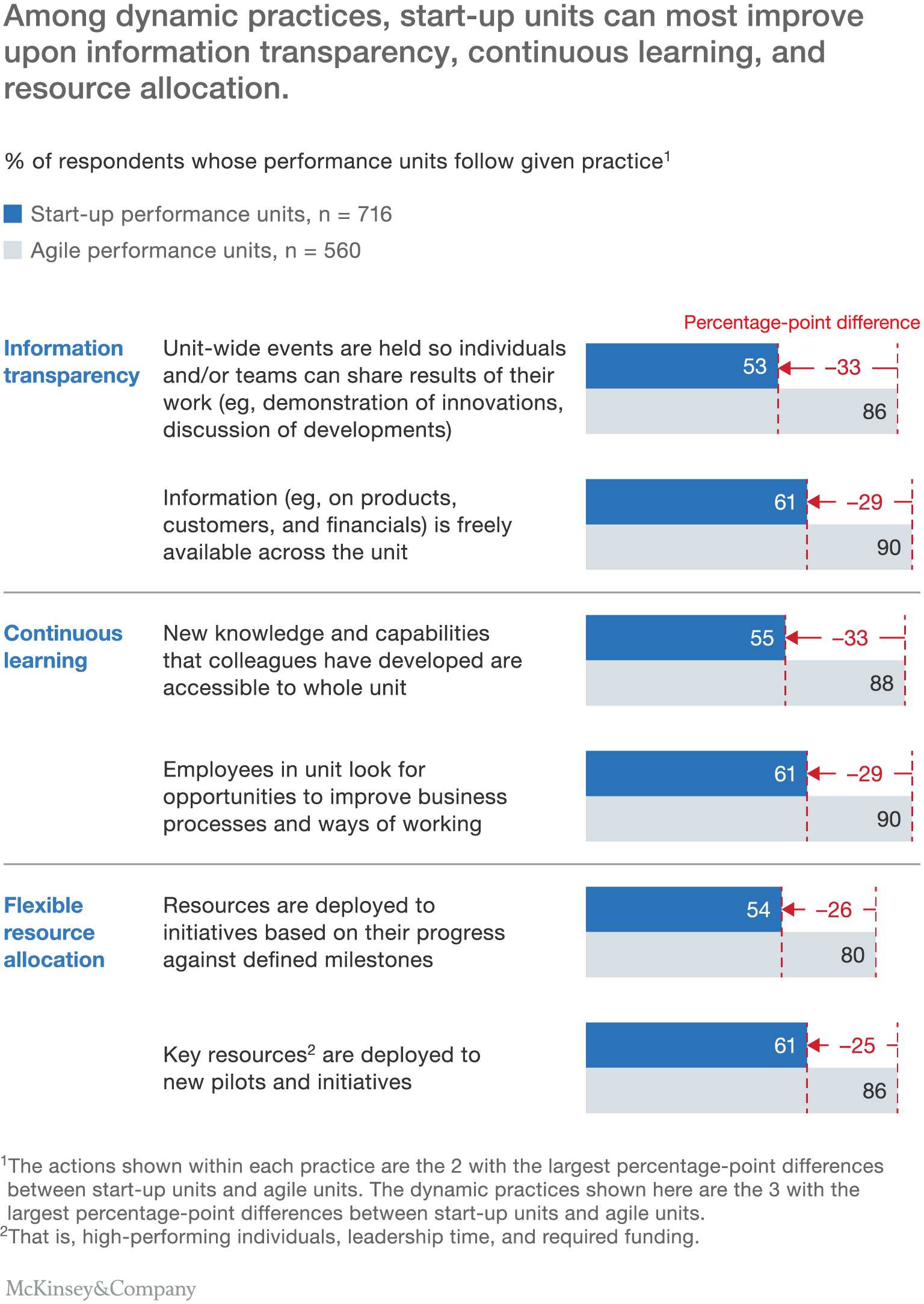
Trapped units
The trapped units are often associated with firefighting, politics, a lack of coordination, protecting turf, and local tribes. These organizations find themselves lacking both a stable backbone and dynamic capabilities. In applying the stable practices, the trapped units are most behind on those related to people: specifically, shared and servant leadership and entrepreneurial drive. Just 13 percent of respondents at trapped units say they follow shared and servant leadership, compared with 89 percent of their agile peers. The dynamic practices in which they are furthest behind are process related, especially continuous learning and rapid iteration and experimentation.
Looking ahead
In response to the challenges that the survey results revealed, here are some principles executives and their units or organizations should act upon, whether or not they have already begun agile transformations:
- Embrace the magnitude of the change. Based on the survey, the biggest challenges during agile transformations are cultural—in particular, the misalignment between agile ways of working and the daily requirements of people’s jobs, a lack of collaboration across levels and units, and employee resistance to changes. In our experience, agile transformations are more likely to succeed when they are supported by comprehensive change-management actions to cocreate an agile-friendly culture and mind-sets. These actions should cover four main aspects. First, leaders and people across the organization align on the mind-sets and behaviors they need to move toward. Second, they role-model the new mind-sets and behaviors and hold each other accountable for making these changes. Third, employees are supported in developing the new skills they need to succeed in the future organization. And finally, formal mechanisms are put in place to reinforce the changes, rewarding and incentivizing people to demonstrate new behaviors.8
- Be clear on the vision. The results show that agile units excel most at creating a shared vision and purpose and aligning on this vision through actionable strategic guidance. In contrast, at companies that have not yet started a transformation, one of the most common limitations is the inability to create a meaningful or clearly communicated vision. An important first step in deciding whether to start an agile transformation is clearly articulating what benefits are expected and how to measure the transformation’s impact. This vision of the new organization must be collectively held and supported by the top leadership.
- Decide where and how to start. Respondents whose organizations have not started agile transformations most often say it’s because they lack a clear implementation plan. While the right plan will vary by company, depending on its vision, companies should first identify the part(s) of the organization that they want to transform and how (for example, by prototyping the changes in smaller parts of the performance unit before scaling them up, or by making changes to more foundational elements that go beyond a single unit). Second, they should assess which of the 18 agile practices the organization most needs to strengthen in order to achieve agility, so that the actions taken across strategy, structure, process, people, and technology are mutually reinforcing. Third, they should determine the resources and time frame that the transformation requires, so the effort maintains its momentum but the scope remains manageable at any point in time.



